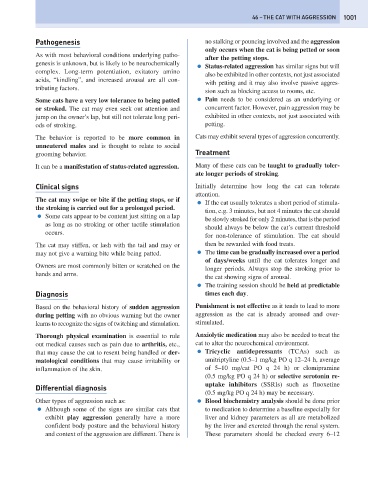Page 1009 - Problem-Based Feline Medicine
P. 1009
46 – THE CAT WITH AGGRESSION 1001
Pathogenesis no stalking or pouncing involved and the aggression
only occurs when the cat is being petted or soon
As with most behavioral conditions underlying patho-
after the petting stops.
genesis is unknown, but is likely to be neurochemically
● Status-related aggression has similar signs but will
complex. Long-term potentiation, exitatory amino
also be exhibited in other contexts, not just associated
acids, “kindling”, and increased arousal are all con-
with petting and it may also involve passive aggres-
tributing factors.
sion such as blocking access to rooms, etc.
Some cats have a very low tolerance to being patted ● Pain needs to be considered as an underlying or
or stroked. The cat may even seek out attention and concurrent factor. However, pain aggression may be
jump on the owner’s lap, but still not tolerate long peri- exhibited in other contexts, not just associated with
ods of stroking. petting.
The behavior is reported to be more common in Cats may exhibit several types of aggression concurrently.
unneutered males and is thought to relate to social
grooming behavior. Treatment
It can be a manifestation of status-related aggression. Many of these cats can be taught to gradually toler-
ate longer periods of stroking.
Clinical signs Initially determine how long the cat can tolerate
attention.
The cat may swipe or bite if the petting stops, or if
● If the cat usually tolerates a short period of stimula-
the stroking is carried out for a prolonged period.
tion, e.g. 3 minutes, but not 4 minutes the cat should
● Some cats appear to be content just sitting on a lap
be slowly stroked for only 2 minutes, that is the period
as long as no stroking or other tactile stimulation
should always be below the cat’s current threshold
occurs.
for non-tolerance of stimulation. The cat should
The cat may stiffen, or lash with the tail and may or then be rewarded with food treats.
may not give a warning bite while being patted. ● The time can be gradually increased over a period
of days/weeks until the cat tolerates longer and
Owners are most commonly bitten or scratched on the
longer periods. Always stop the stroking prior to
hands and arms.
the cat showing signs of arousal.
● The training session should be held at predictable
Diagnosis times each day.
Based on the behavioral history of sudden aggression Punishment is not effective as it tends to lead to more
during petting with no obvious warning but the owner aggression as the cat is already aroused and over-
learns to recognize the signs of twitching and stimulation. stimulated.
Thorough physical examination is essential to rule Anxiolytic medication may also be needed to treat the
out medical causes such as pain due to arthritis, etc., cat to alter the neurochemical environment.
that may cause the cat to resent being handled or der- ● Tricyclic antidepressants (TCAs) such as
matological conditions that may cause irritability or amitriptyline (0.5–1 mg/kg PO q 12–24 h, average
inflammation of the skin. of 5–10 mg/cat PO q 24 h) or clomipramine
(0.5 mg/kg PO q 24 h) or selective serotonin re-
uptake inhibitors (SSRIs) such as fluoxetine
Differential diagnosis
(0.5 mg/kg PO q 24 h) may be necessary.
Other types of aggression such as: ● Blood biochemistry analysis should be done prior
● Although some of the signs are similar cats that to medication to determine a baseline especially for
exhibit play aggression generally have a more liver and kidney parameters as all are metabolized
confident body posture and the behavioral history by the liver and excreted through the renal system.
and context of the aggression are different. There is These parameters should be checked every 6–12

